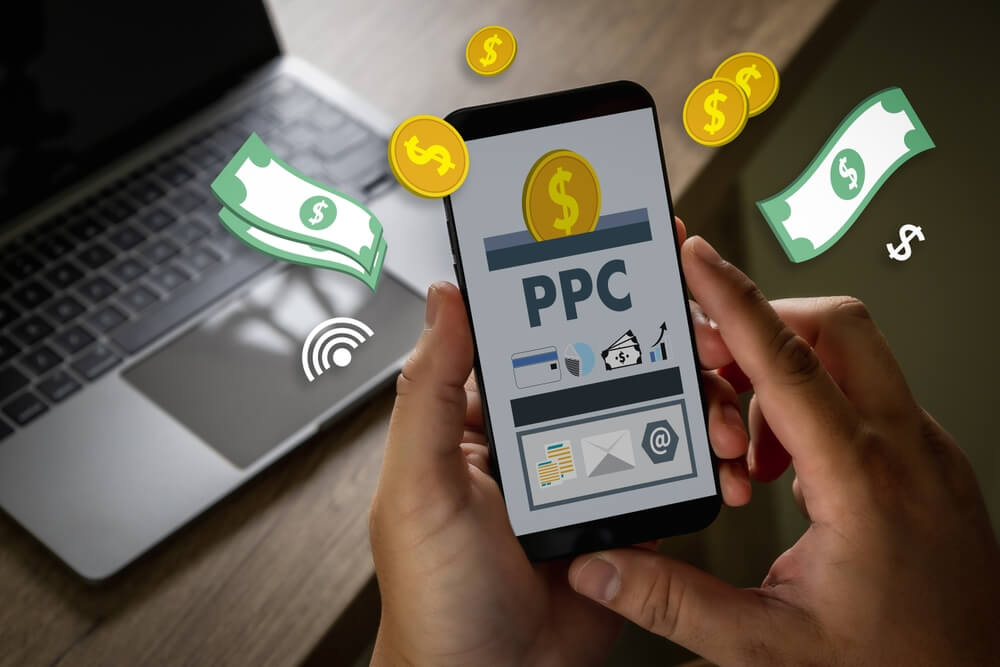
PPC Bid Management: What Pros Know But You Don’t
Are you struggling to understand the ins and outs of pay-per-click (PPC) bid management? Take a deep breath and relax because you are not alone. Many businesses, both small and large, struggle to understand how to effectively manage their bids and get the best results from their campaigns. With more and more businesses shifting their attention to digital marketing, it has become crucial to create an effective PPC strategy to drive targeted traffic to your website and boost conversions. Working closely with a PPC Agency can help you realize the value of implementing a successful PPC campaign. In this article, we will discuss the basics of PPC bid management and how industry pros – and you, too – can use it to great advantage.
Let's plunge into the realm of PPC and learn how it can be a game-changer for your business.
If you want to learn how Digital Authority Partners can increase your PPC effectiveness, watch this video!
PPC Advertising: Your Ultimate Weapon in Dominating Your Industry
PPC, or pay-per-click, is a popular method of digital advertising that is used to attract customers to websites. These are the ads you see on Google, Bing, or other search engines you may use. According to a recent survey most small to mid-sized companies put their marketing budget toward creating a digital strategy and a majority of those who have used PPC have seen an increase in their return on investment (ROI). In fact, PPC can return $2 for every $1 spent resulting in a 200% ROI. This means that PPC is one of the most effective digital marketing tools available today.
Essentially, PPC is a way to buy visits to your website instead of earning them organically through search engine optimization (SEO). For example, let's say you own a deli in New York City, and you want to reach people who are searching for "best corned beef sandwich near me." You can create a PPC campaign and bid on specific keywords like "New York City corned beef." Depending on your bid amount, your ad will appear at the top of the search results when someone searches the keywords “New York City Corned Beef.” When a user clicks on your ad, you pay a fee, and they're directed to your website. PPC allows you to target your audience and drive them to your site. You only pay when someone clicks on your ad.
PPC bid management is the process of strategically raising and lowering keyword bids in order to get the most out of your PPC budget. It involves understanding the bidding landscape and then setting a bid amount that maximizes your return. You use keyword research tools to track your competition and determine the cost for specific keywords. Also research similar keywords closely related to your product or service, because these can often produce higher returns than exact match terms. Utilizing an experienced PPC agency not only helps you understand the best practices for bid management, but could help you boost your overall profits.
When setting a bid amount, you must set goals to measure success. Goals could include driving traffic to a website, increasing sales, or improving brand awareness. By setting clear objectives and tracking progress, businesses can make educated decisions about how much to bid for each keyword and thereby maximize their ad budget.
Four Key Factors To Think About Before You Start Managing Bids

To lay the groundwork for PPC bid management success, start with key steps: identify goals and key performance indicators (KPIs), define what success is for your campaign, conduct a competitive analysis, and determine your goal return on ad spend (ROAS).
1. Identify KPIs: Identify your goals and Key Performance Indicators (KPIs) before launching a PPC campaign. This involves determining what specific actions you want users to take on your website. Do you want them to make a purchase, fill out a lead form, or download a white paper? Once you know your goals clearly, you can set KPIs to measure your success, such as click-through rate (CTR), conversion rate, cost per conversion, and return on ad spend (ROAS).
2. Define Success: Defining success is the next crucial step in PPC bid management. This involves setting realistic expectations for your campaigns and determining what success looks like for your business. For example, if your goal is to increase sales, you'll need to calculate your desired return on investment (ROI) and set your bids accordingly. Similarly, if your goal is to increase brand awareness, you may be more focused on metrics like CTR and impressions.
3. Analyze Competitors: Another key component of PPC bid management is conducting a competitive analysis. This involves researching your competitors to see what keywords they are targeting, what ad copy they are using, and how much they are bidding on certain keywords. This information can help you better understand the competitive landscape and adjust your bidding strategy accordingly. For example, if you are in a highly competitive industry such as car sales, you may need to bid more aggressively to ensure your ads are showing up in relevant search results.
4. Calculate ROAS: Determining your goal return on ad spend (ROAS) is also critical to successful PPC bid management. ROI and ROAS differ. ROAS is the measure of how much you are getting back for every dollar you spend on your ads in a specific campaign; it focuses on the revenue of that campaign, whereas ROI focuses on overall profit. To determine your goal ROAS, you need to factor in things like the average order value, cost per click (CPC), and conversion rate.
In addition to these key components, consider a number of other factors related to PPC bid management. These include ensuring that your ad copy is related to your targeted keywords, that your landing pages are optimized for conversions, and that you are tracking key metrics like bounce rate and time on site. By carefully managing all of these components, you can improve the performance of your PPC campaigns and drive more traffic and conversions to your website.
Creating Compelling Ads: A Deep Dive into the Key Elements of PPC Bid Management
The purpose of PPC management is to ensure 1) that your ads are relevant to your target audience, 2) that they are engaging, and most importantly, 3) that they are profitable. So, let's dive into the key elements of effective PPC management.
One crucial aspect of PPC management is Ad Rank and Quality Score. Ad Rank is the position of your ad in search engine results, and Quality Score is a metric that assesses the relevance and quality of your ad. To improve your Ad Rank and Quality Score, you must ensure that your ad copy and destination page, such as a landing page or a specific page on your website, are related to your keywords. The higher your relevance, the lower your cost per click (CPC) will be. Collaborating with a Google Ads Agency can give you the competitive edge you need so your ad campaigns perform at their very best. With their expertise, you can rest assured that your Ad Rank and Quality Scores are optimized to drive maximum engagement and conversions.
One of the most important tasks you can do for your ads is to make sure that they include eye-catching headlines and compelling ad copy. Your goal is to grab the attention of your target audience, and your ad copy should be persuasive enough to do that. When designing your ads, take a hard look at your competitors’ successful ads to figure out why they attract viewers. Examining other PPC ad examples will give you insights for your own ads. Additionally, including calls to action in your ads can encourage users to take action, such as clicking on your ad or making a purchase. Take a look at the following example:
Headline: Create your Dream Patio - Summer Clearance on all Patio Furniture!
Description: Shop now and save up to 50% off on all patio furniture. Only through June. Free delivery on orders over $250. Don't miss out!
In this example, the headline is attention-grabbing, as it highlights a sale on furniture and creates a sense of urgency and excitement for the customer. The description offers a discount and free delivery, which can entice customers to click on the ad and make a purchase. The call to action, "Shop now and save up to 50% off," is straightforward and encourages the customer to take immediate action. By using a combination of an engaging headline, an enticing offer, and a clear call to action, this PPC ad has the potential to drive clicks and deliver conversions.
Another crucial aspect of PPC bid management is targeting, which refers to the process of identifying and reaching your ideal audience. With effective targeting, you can ensure that your ads are displayed to the right people at the right time. This can be achieved through various methods, such as geographic targeting, demographic targeting, and keyword targeting. In the above example, the furniture store may want to target the Midwest in June knowing that customers are more likely to want to spend more time outdoors before the winter months return.
Finally, you do not want to take a “set it and forget it” mentality when it comes to your ads. You should continually monitor your campaigns, analyze the data, and adjust your strategies accordingly. This can help you optimize your campaigns and maximize your return on investment or return on ad spend.
By incorporating these elements into your PPC strategy, you can create successful campaigns that generate leads, increase sales, and grow your business.
PPC Ads 101: How to Create Winning Campaigns that Drive Traffic

As we discussed earlier, there are several components that you need to juggle to ensure that your campaigns are successful. Let's take a look.
1. Your ad headlines, ad copy, images, video, sitelinks, and other elements should be engaging and persuasive, encouraging potential customers to click through to your website.
2. Consider the type of ad you are using. Different ad types such as search, local, shopping, and video require distinctive bidding techniques to achieve the highest return on investment.
3. Your targeting parameters are also crucial for successful PPC bid management. You need to consider geographic and demographic parameters to ensure that your ads are being seen by the right people. You may receive fewer clicks, but your qualified visitors will increase. For example, if your business only serves customers in the Atlanta area, you do not want your ads shown to people in California. Similarly, if your product is primarily marketed towards a certain age group, you want to ensure that your ads are targeted towards that demographic. When you need Los Angeles content, you go to an LA content marketing agency. When you need Atlanta-focused content, you need Atlanta content marketing agency services.
4. You also want to set up your campaign to retarget potential customers. Retargeting is important because it allows you to show ads to people who have previously interacted with your website, encouraging them to return and complete a purchase or take another desired action.
5. Finally, the big elephant in the room when it comes to PPC bid management is your PPC budget. You need to determine how much you are willing to spend on your ads, and then set your bids accordingly. Average CPCs (cost per click) will vary depending on your industry, the competitiveness of your keywords, and other factors. Keep track of your CPCs and adjust your bids as needed to ensure that you are getting the most value for your budget.
Ultimately, the success of your PPC campaigns depends on your average conversion rate and your average conversion value. Your conversion rate is the percentage of people who click on your ad and then complete a desired action, such as making a purchase. Your conversion value is the average amount of revenue generated by each conversion. By tracking these metrics, you can determine which campaigns are performing well and which ones need to be adjusted.
As you can see, PPC bids require careful attention to many different components. By taking a strategic approach and analyzing your results, you can create successful campaigns that drive traffic and revenue for your business.
The Dynamic Duo: Landing Pages and Keywords
Having high-quality landing pages and/or product pages that are relevant to your keywords is essential to achieve the best results and improve your ad rank.
When it comes to PPC advertising, the ultimate goal is to drive conversions and increase ROI. Landing pages play a critical role in achieving these objectives. When users click on your ad, they should be taken to a simple and focused landing page that is optimized to convert.
Your landing page should be aligned with the message conveyed in your ad copy, and the user should be able to easily find what they are looking for. The simpler the journey for the visitor, the better chance of a conversion.
Another critical aspect of your landing pages is the conversion funnel. The conversion funnel is made up of four stages - awareness, interest, desire, and action. Your landing page should be designed to guide your visitors through each of these stages, from initial awareness of your product or service, to a desire to learn more, to a final action, such as making a purchase or filling out a contact form.
Tracking user activity on your landing page is also crucial in improving your ad rank. By tracking user behavior, you can identify areas of improvement in your landing page and make the necessary changes to improve your ad rank. For example, if users are not staying on your landing page for long or bouncing quickly, this may indicate that your landing page is not relevant to the user's search intent. You may need to adjust your landing page content so that it is more relevant to your PPC ads. Remember, when the user clicks on your ad and is taken to a landing page that is relevant to their search, it increases the likelihood of conversion. This relevance also signals to Google that your landing page is of high quality and relevant, which can improve your ad rank and lower your CPC.
Let’s take a look at the following example:
Suppose you are running a PPC campaign for a coffee shop that offers delivery services. Your ad copy includes the keyword "coffee delivery," and takes the user to a landing page that is specifically designed for coffee delivery services. This landing page includes information about the delivery process, available menu items, and how to place an order. By keeping the landing page focused on coffee delivery services, the user is more likely to convert. In addition, the ad rank improves as Google “sees” the relevance of the landing page to the user's search intent.
Remember: when building out your landing pages, make them tightly relevant to the keywords you use in your PPC ad copy.
Beyond Bid Management: How Analytics and Attribution Can Take Your PPC Campaigns to the Next Level

Now that you have mastered the PPC bid management process, let's explore the significance of analytics and attribution in PPC advertising. Analytics and attribution are critical components to understanding a PPC campaign. By tracking key metrics and understanding how your campaigns are driving conversions, you can make data-driven decisions that help you optimize your budget, improve your ad performance, and drive better results for your business.
One of the most important tools for tracking your PPC campaigns is UTM parameters. These parameters are tags that you can add to your campaign URLs to track where your traffic is coming from. By including UTM parameters in your links, you can see which campaigns, keywords, and ads are driving the most traffic and conversions to your site.
Conversion tracking is another critical aspect of analytics and attribution. By setting up conversion tracking, you can track specific actions that users take on your website, such as making a purchase or filling out a form. This information helps you understand which campaigns are driving the most conversions so you can adjust your PPC strategy accordingly.
When it comes to whether your sales are business-to-consumer (B2C) or business-to-business (B2B), the types of conversions you are tracking may differ. For B2C businesses, the focus is often on ecommerce sales, while for B2B businesses, the focus is more on lead generation. Understanding the different types of conversions you are tracking can help you optimize your campaigns for maximum ROI.
In addition to tracking conversions, consider in or post-session sales attribution. This means tracking how your PPC campaigns are influencing sales both during and after a user's initial session on your site. Multi or last touch attribution can help you understand which campaigns and touchpoints are most influential in driving conversions, so you can optimize your budget and allocate resources accordingly.
Performance-based budget allocation is the process of allocating your budget based on the performance of your PPC campaigns. By analyzing your campaign performance, you can identify which campaigns are most profitable and shift your budget towards those campaigns.
For example, suppose you are running a PPC campaign for a shoe store, and you have multiple campaigns running on different platforms such as Facebook, Instagram, and Google Ads. Tracking UTM parameters tells you which platform is driving the most traffic to your website.
By tracking conversions, you see which campaigns are driving the most sales or inquiries. Using this information, you can adjust your budget allocation and messaging to focus on the most profitable campaigns.
Using UTM parameters tracking, conversion tracking, and attribution methods, you can better understand your campaign performance and optimize your budget allocation. And by shifting your budget towards the most profitable campaigns, you can drive more conversions and increase ROI.
Let’s Review
Congratulations! You are officially a PPC Bid Management Guru. So in conclusion, whether you want to drive more sales or increase brand awareness, keep in mind what we discussed to help you create a successful PPC campaign that delivers real results.
1. First, identify your business goals. Do you want to drive more website traffic, generate leads, or increase online sales? Once you have identified your goals, you can create ads that are designed to achieve those objectives. Carefully craft ad copy, select appropriate images or videos, and include compelling calls-to-action that encourage users to take action.
2. Launch your campaigns in your target markets. Make sure you select the appropriate keywords, set your bidding strategy, and select the geographic and demographic targeting options that are most relevant to your business.
3. Have a well-optimized landing or product page that is relevant to the keywords you are using in your PPC campaign. The simpler the customer journey, the more likely a conversion.
4. Track interactions across demographics. Monitor how users engage with your ads and website, including how long they stay on your site, which pages they visit, and whether they complete any desired actions, such as making a purchase or filling out a form.
5. Identify the most profitable opportunities for your business. This includes identifying the keywords, ads, and targeting options that are driving the most conversions at the lowest cost. With this data, you can optimize your strategy, shifting your budget and resources to those efforts that are driving the most value for your business.
Overall, the key to running a successful PPC campaign is to adopt a data-driven approach. An effective PPC Agency has the ability to assist you in reaching your online advertising objectives by utilizing their proficiency in pay-per-click marketing strategies and optimization techniques. By identifying your business goals, creating ads that are designed to achieve those objectives, launching campaigns in your target markets, tracking interactions across demographics, and optimizing your strategy based on data, you can develop a winning PPC campaign that delivers real value and growth for your business.
If you would like some personalized direction for your PPC campaigns, contact Digital Authority Partners.
Want To Meet Our Expert Team?
Book a meeting directly here




